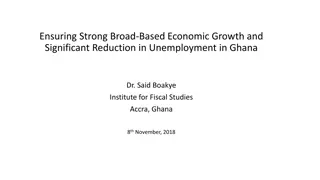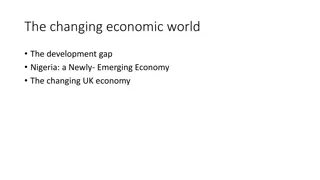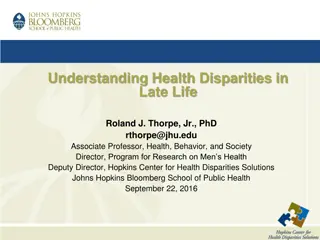Understanding Global Economic Disparities and Growth Trends
Explore the significant differences in living standards and economic growth rates across countries, from advanced economies like the UK to middle-income nations like Mexico and low-income countries like Mali. Real GDP per capita, life expectancy, literacy rates, and growth data provide insights into global economic dynamics. Learn how Real GDP per capita is calculated, the Rule of 70 for estimating economic growth, and the impact on living standards over time.
Download Presentation

Please find below an Image/Link to download the presentation.
The content on the website is provided AS IS for your information and personal use only. It may not be sold, licensed, or shared on other websites without obtaining consent from the author. Download presentation by click this link. If you encounter any issues during the download, it is possible that the publisher has removed the file from their server.
E N D
Presentation Transcript
Economic Growth and Productivity Modules 37 & 39
A typical family with all their possessions in the U.K., an advanced economy Real GDP per capita: $36,600 Life expectancy: Adult literacy: 80 years 99%
A typical family with all their possessions in Mexico, a middle income country Real GDP per capita: $14,800 Life expectancy: Adult literacy: 76 years 93%
A typical family with all their possessions in Mali, a poor country Real GDP per capita: $1,100 Life expectancy: Adult literacy: 51 years 47%
GDP per capita, 2012 $8,500 60,500 35,200 31,000 31,400 3,700 49,000 41,100 10,400 28,000 4,100 17,700 24,500 1,400 1,300 Growth rate, 2006- 10 10.6% 2.9% 0.5% -0.3% 2.2% 7.1% 0.1% 0.1% 3.1% 0.4% 3.2% 5.9% Incomes and Growth Around the World China Singapore Japan Spain Israel India United States Canada Colombia New Zealand Philippines Argentina Saudi Arabia Rwanda Haiti FACT 1: There are vast differences in living standards around the world. 0% 4.4% 0.5%
GDP per capita, 2012 $8,500 60,500 35,200 31,000 31,400 3,700 49,000 41,100 10,400 28,000 4,100 17,700 24,500 1,400 1,300 Growth rate, 2006- 10 10.6% 2.9% 0.5% -0.3% 2.2% 7.1% 0.1% 0.1% 3.1% 0.4% 3.2% 5.9% Incomes and Growth Around the World China Singapore Japan Spain Israel India United States Canada Colombia New Zealand Philippines Argentina Saudi Arabia Rwanda Haiti FACT 2: There are vast differences in growth rates. 0% 4.4% 0.5%
Real GDP per capita Real GDP per capita real GDP divided by the population size. Focus on RGDP per capita to isolate the effects of changes in the population. United States RGDP - $15 trillion China RGDP - $7.3 trillion Per capita RGDP US: $50,000 and China: $8,500 Today more than 50% of the world s people live in countries with a lower standard of living than the U.S. had a century ago.
How Do We Estimate Economic Growth? The Rule of 70 A rule stating that the number of years required for per capital RGDP to double is equal to 70 divided by the average rate of economic growth Example: At an annual growth rate of 10%, per capita real GDP should double in about:
Productivity A country s standard of living depends on its ability to produce goods & services. Sustained economic growth in real GDP per capita occurs only when the amount of output produced by the average worker increases steadily. This ability depends on productivity: the average quantity of goods & services produced per unit of labor input. Example: Robinson Crusoe Because he is stranded alone, he must catch his own fish, grow his own vegetables, and make his own clothes. His standard of living depends on his ability to produce goods and services.
Determinants of Productivity Physical Capital Human Capital Technological Knowledge
Physical Capital Physical capital the stock of equipment and structures that are used to produce goods and services. Productivity is higher when the average worker has more capital (machines, equipment, etc.). Example: Crusoe will catch more fish if he has more fishing poles.
Human Capital Human capital the knowledge and skills that workers acquire through education, training, and experience. Productivity is higher when the average worker has more human capital (education, skills, etc.). Example: Crusoe will catch more fish if he has been trained in the best fishing techniques.
Technological Knowledge Technological knowledge: society s understanding of the best ways to produce goods & services Technological progress does not only mean a faster computer, a higher-definition TV, or a smaller cell phone. It means any advance in knowledge that boosts productivity (allows society to get more output from its resources). e.g., Henry Ford and the assembly line.
Technological Knowledge vs. Human Capital Technological knowledge refers to society s understanding of how to produce goods & services. Human capital results from the effort people expend to acquire this knowledge. Both are important for productivity.
Physical Capital: Saving and Investment We can boost productivity by increasing capital, which requires investment spending. Since resources are scarce, producing more capital requires producing fewer consumer goods. Reducing consumption = increasing saving. This extra saving funds the production of investment goods. Hence, a tradeoff between current and future consumption. How can government help? Giving businesses tax breaks on capital investment Giving savers tax breaks on interest income
Investment from Abroad Saving by domestic residents is not the only way for a country to invest in new capital. To raise the amount of capital per worker, the government can also encourage Foreign direct investment: a capital investment (e.g., factory) that is owned & operated by a foreign entity. Foreign portfolio investment: a capital investment financed with foreign money but operated by domestic residents (stock or bond purchases)
Government and Investment in Physical Capital Government provides physical capital by building infrastructure roads, power lines, ports, information networks Government can insure the soundness of the banking system through regulation. Without faith in banks there is no saving or investment.
ECONOMIC GROWTH AND PUBLIC POLICY How can public policy affect long-run growth in productivity and living standards?
Human Capital: Education Government can increase productivity by promoting education investment in human capital. public schools, subsidized loans for college Education has significant effects: In the U.S., each year of schooling raises a worker s wage by 10%. Health care expenditure is a type of investment in human capital healthier workers are more productive. In countries with significant malnourishment, raising workers caloric intake raises productivity
Technology: Research and Development R & D: Spending to create and implement new technologies. Technological progress is the main reason why living standards rise over the long run. Policies to promote tech. progress: patent laws tax incentives or direct support for private sector R&D grants for basic research at universities government R&D: NASA, Center for Disease Control
Property Rights and Political Stability Recall: Markets are usually a good way to organize economic activity. The price system allocates resources to their most efficient uses. This assumes private ownership of resources. This requires respect for property rights, the ability of people to exercise authority over the resources they own.
Property Rights and Political Stability Economic stability, efficiency, and healthy growth require law enforcement, effective courts, a stable constitution, and honest government officials. In many poor countries, the justice system doesn t work very well - fraud, corruption and bribery are common Political instability (e.g., frequent coups) creates uncertainty over whether property rights will be protected in the future. Investment in human & physical capital will be lower if people and corporations are fearful that they may lose their property.
Is World Growth Sustainable? Sustainable: describes continued long-run economic growth in the face of limited supply of natural resources and exponential population growth. Technological progress often yields ways to avoid these limits: Hybrid cars use less gas. Better insulation in homes reduces the energy required to heat or cool them. As a resource becomes scarcer, its market price rises, which increases the incentive to conserve it and develop alternatives.
Population Growth may affect living standards in 3 different ways: 1. Stretching natural resources 2. Diluting the capital stock More population per a fixed stock of capital means less capital per worker Capital stock must increase at least as fast as the population to maintain current standards
Population Growth 3. Promoting tech. progress A larger population may promote technological progress. Throughout history, most technological progress has come from larger population centers where there are more people to discover things and exchange ideas. = more scientists, inventors, engineers = more frequent discoveries = faster tech. progress & economic growth
Economic Growth and the Environment China has achieved tremendous economic growth, but has also increased air pollution in that nation s cities. Air pollution causes health problems for workers which lower productivity. Air pollution causes a greenhouse effect, which can lead to higher temperatures, create droughts, and other extreme weather events. These events negatively impact economic growth.

 undefined
undefined






















